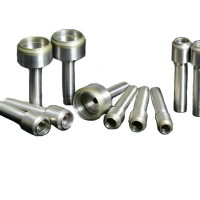Glass has been colored, cut, and cast into endless shapes and hues for countless purposes from architecture to art and industry.
Today, glass is one of the foremost materials in modern architecture. More glass is being manufactured than ever before, and the demand for detailed, exacting pieces is higher than ever. For that reason, glass producers have turned to the latest manufacturing technology to produce glass pieces to exact dimensions and in unusual shapes.
Glass cutting poses several challenges. If done incorrectly, glass can shatter or chip, ruining an otherwise good piece. Today’s glass cutting is largely done using CNC routers, specialist machine tools designed to cut glass carefully and precisely. The integration of digital technologies like CNC is opening up new avenues for glass production to be faster, more accurate, and innovative than ever before.
What is CNC?
Computer Numerical Control (CNC) technology allows operators to program machine tools with preset instructions. Using G-code, operators instruct a mill or router to move the cutting tool to a certain point, turn the tool on, cut to a specific depth, move to a new point, and so on. An entire cutting operation can be designed and programmed to run automatically, with no human interference. When coupled with a water cooling system, CNC routers can cut glass precisely and automatically, without the little variations that come when cutting using manually-control machines. Glass-cutting CNC machines are capable of greater accuracy and more complex operations than manual cutting.
How does CNC work?
A typical glass-cutting CNC router uses a cutting tool mounted on a tool head suspended from a gantry. The gantry is fixed above the workpiece and gives the cutting tool full movement along the X, Y, and Z-axes. Glass-cutting CNC machines are water-cooling to prevent damage to the surrounding material.
The actual CNC machine itself relies on a computer to control the cutting tool. The process starts long before an operator initiates the program. Most CNC programs begin on a computer somewhere else, often in a Computer Assisted Design program. CAD programs allow designers to visual and digitally construct a particular part or even an entire building. More importantly, these programs enable designers to input the dimensions of the part they need to build, and then generate a vector file based on those dimensions.
That vector file can then be input into the CNC machine. Some modifications may need to be made, but the core of the program should be ready to go. An operator only needs to load the workpiece and start the program.
Why Process Glass with Digital Assistance?
By using CAD programs and CNC machines, the entire lifecycle of a new part can be digitized. For a piece of architectural glass, that design may start as part of an architect's digital model. Using the dimensions given in that model, a vector file is created for a particular glass pane or window. Any unique aspects, such as glass edge bevels or grooves, will be reflected in the file. That file can then be entered into a CNC mill and converted into G-code, the actual instructions that will be executed by the machine itself.
Processing glass with digital assistance provides three major benefits:
Fewer limitations: Modern CNC machines can handle workpieces with complex geometries and large sizes. They can shape edges or drill holes without damaging the surrounding material. High-end CNC machines can change tools multiple times in an operation, allowing them to perform rough and finishing work at the same time.
Increased precision: Digital glass processing is capable in some cases of tolerances as low as 0.005", or five one-thousandths of an inch. With such narrow tolerances, glass manufacturers can include features like pockets or slots in their products, and be assured that any pieces will fit together.
Greater creativity: The adage with CNC and digital processing technologies like CAD is "if you can draw it, you can CNC it." There's almost no limit to the size or shape of the workpieces that can be processed, and this allows designers to use glass in increasingly creative ways.
How to Apply Digital Technology to Glass Processing
Adding CNC tooling capacity to your glass processing line opens up a world of new possibilities. Some of the processes routinely applied to CNC glass include:
- Edge beveling
- Surface profiling (interior and exterior)
- Corner dubbing
- Pockets, slots, and blind holes
- Hole drilling
These processes can be applied to nearly any kind of glass, from shatterproof glass to teleprompter mirrors. In short, using the complete digital process of CAD programs and CNC machining allows any company to vastly expand the range of glass finishing processes they offer.
About the Author:
Peter Jacobs

Peter Jacobs is the Senior Director of Marketing at CNC Masters. He is actively involved in manufacturing processes and regularly contributes his insights for various blogs in CNC machining, 3D printing, rapid tooling, injection molding, metal casting, and manufacturing in general.























